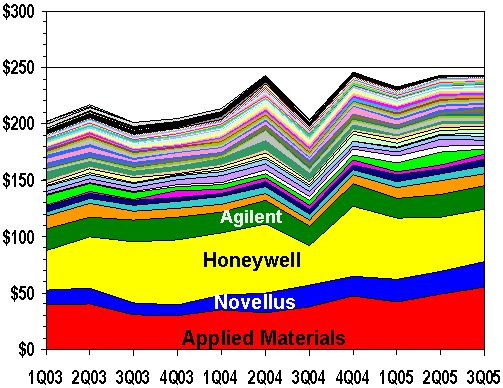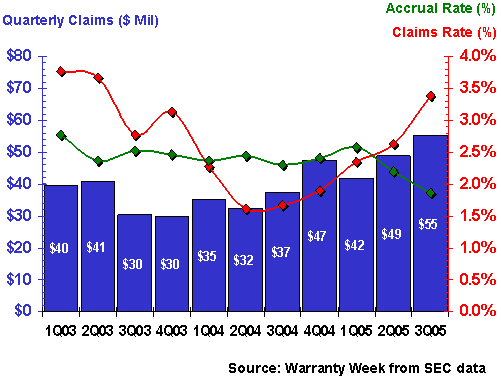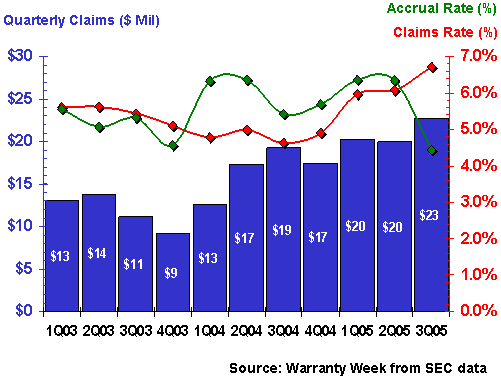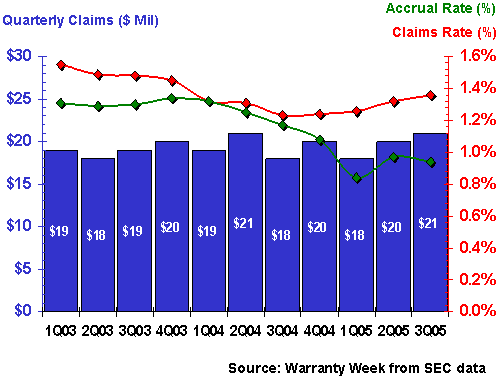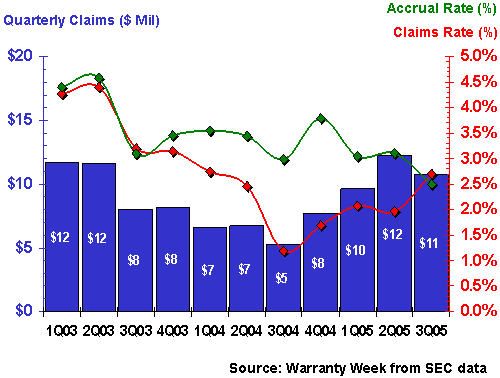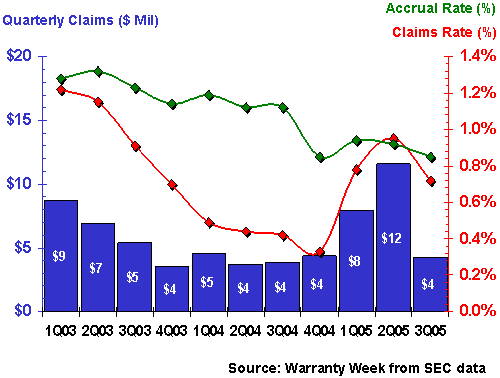December 6, 2005 |

|
ISSN 1550-9214 |
Semiconductor Warranties:In most industries, the consumer-facing brand name suffers most of the warranty cost, and their suppliers get off lightly. But with semiconductors, it's the production platform providers who are left holding the bag.Semiconductor and printed circuit board manufacturers pay out an average of only 1.2% of product revenue to honor warranty claims. But that's far from the end of the story. In an interesting turn of events, those with the highest warranty costs are the makers of the chip-producing machinery, while those with the lowest expenses are those who make the chips themselves. Warranty Week has gathered together the warranty expenditures reported by some 114 U.S.-based manufacturers of semiconductors, printed circuit boards, wafer fabricating equipment, and test equipment used for the production of semiconductors. As Figure 1 below illustrates, however, the vast majority of the warranty spending in this industry comes from perhaps a dozen firms. Total Industry SpendingIn the chart below, the total warranty spending by the 114 manufacturers added up to $243 million during both the second and third quarters of 2005, up slightly from $233 million in the first quarter. Spending during the equivalent nine months of 2004 totaled $661 million, so warranty claims are up almost 9% year to year. Meanwhile, warranty claims during the first nine months of 2003 were $620 million. Warranty expenditures for Applied Materials, Honeywell, Novellus, and Agilent Technologies are labeled. KLA-Tencor is in orange. Cymer is teal. Lam Research is navy blue. Mattson Technology is pink. And Advanced Micro Devices is bright green. For those with the vision of a hawk, Credence Systems is portrayed in white, and Coherent Inc. is in lavender. We should note that in the case of Coherent and roughly 10 other manufacturers, we had to use placeholder estimates for the third quarter since the companies ended their fiscal years on or about Sept. 30, and won't be filing their annual reports until later this month. Figure 1 | ||||||||||||||||||||||||||||||||||||||||||||||||||||||||||||||||||||||||||||||||||||||||||||||||||||||||
| Back to Part Four | Go to Part Six |

|
This Week’s Warranty Week Headlines | ||
|
Sun Microsystems to sell three year service contracts along with new Sun Fire T1000 and T2000 system. Press Release, December 6, 2005 | ||
|
Honey, they shrunk the warranty: some PCs and CE now sold with only 90-day coverage. Bankrate.com, December 6, 2005 | ||
|
J.D. Power ranks Caterpillar C-15 heavy-duty truck diesel engine highest in customer satisfaction. Press Release, December 6, 2005 | ||
|
Fitch Ratings revises outlook for Aon Corp. upwards from negative to stable. Press Release, December 6, 2005 | ||
|
Customer says Microsoft Xbox 360 has a design flaw that causes it to overheat and freeze up. Reuters, December 5, 2005 | ||
More Warranty Headlines below | ||

|
Warranty Headlines (cont’d) | ||
|
AMR Research says delaying an auto recall can cost $1 million per day; says Early Warning Systems can cut time by 40%. Press Release, December 5, 2005 | ||
|
Firestone Tire & Service Centers in Washington to refund extended warranties sold in past two years. Seattle Post-Intelligencer, December 3, 2005 | ||
|
Motorpoint to provide first year of warranty coverage for Subaru models it sells in the UK. Auto Industry, December 2, 2005 | ||
|
U.S. passenger car recalls fall in 2005, but Toyota and Ford see increases. Detroit News, December 2, 2005 | ||
|
China's Chery Automobile Co. Ltd. makes its first domestic auto recall announcement; defective mirror light in Oriental Son won't shut off. Asia Pulse, December 1, 2005 | ||
More Warranty Headlines below | ||

|
Warranty Headlines (cont’d) | ||
|
New Tango electric car carries 10-year warranty with on-site repairs. EV World, December 1, 2005 | ||
|
Samsung lengthens computer keyboard and mouse warranties from one to two years. Channel Times, December 1, 2005 | ||
|
Interface launches carpet tiles for schools, backed with a 20-year warranty. Building Products News, December 1, 2005 | ||
|
Deceased musician Jerry Garcia's dishwasher and toilet to be sold "as is" on eBay. BBC News, November 30, 2005 | ||
|
Warranty Direct UK releases list of failure rates and average repair costs for British cars. Press Release, November 29, 2005 (Word file) | ||
More Warranty Headlines below | ||

|
Warranty Headlines (cont’d) | ||
|
Discount retailer Costco is selling Dell desktops and notebooks with a three-year warranty. CNET News.com, November 29, 2005 | ||
|
Analyst sees Best Buy's "Geek Squad" as an advantage vs. Wal-Mart when selling extended warranties. St. Paul Pioneer Press, November 29, 2005 | ||
|
Nassau County Consumer Affairs Department reports a 350% increase this year in complaints regarding Sears. WABC-TV New York, November 28, 2005 | ||
|
Domestic & General Group plc reports higher extended warranty revenues and lower claims rates for half-year ended Sept. 30. Press Release, November 28, 2005 (PDF file) | ||
|
New York Attorney General won't press criminal charges against AIG's Maurice "Hank" Greenberg. Bloomberg News, November 25, 2005 | ||
More Warranty Headlines below | ||

|
Warranty Headlines (cont’d) | ||
|
Asus enters the UK LCD monitor market with a one-year "zero bright dot" warranty. PC Pro, November 24, 2005 | ||
|
Palm Inc. shareholder Sagio Investments urges company to cut its warranty costs. PDA News, November 23, 2005 | ||
|
Carfax now offers a free flood damaged vehicle lookup service on its Web site. Decatur (IL) Herald & Review, November 18, 2005 | ||
|
Intel says computer chips causing problems in China are counterfeits. People's Daily, November 18, 2005 | ||
|
Arizona homeowners unhappy with First American Home Warranty's claims resolution process. KPHO Phoenix, November 18, 2005 | ||
More Warranty Headlines below | ||
|
|
Warranty Headlines (cont’d) | ||
|
Bombardier service center opens at the Dubai airport, to provide regional maintenance and warranty services for Learjet. AME Info, November 19, 2005 | ||
|
Chrysler to lengthen warranties from three to five years and give away free gas with purchases until Jan. 3. Associated Press, November 17, 2005 | ||
|
GM, Ford and Chrysler compete with new rebates and promotions, including longer warranties. CNN Money, November 21, 2005 | ||
|
Sanyo Canada equips new LCD home theatre projector with a three-year warranty. Press Release, November 17, 2005 | ||
|
Norsat International lengthens its microwave equipment warranties to three years. Press Release, November 16, 2005 | ||
More Warranty Headlines below | ||

|
Related Articles From Warranty Week |


